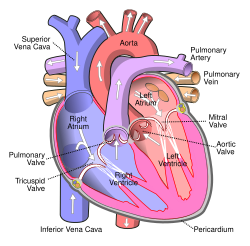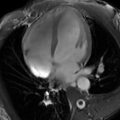Athletic heart syndrome

Editor-In-Chief: Prab R Tumpati, MD
Obesity, Sleep & Internal medicine
Founder, WikiMD Wellnesspedia &
W8MD medical weight loss NYC and sleep center NYC
| Athletic heart syndrome | |
|---|---|

| |
| Synonyms | Athlete's heart, Athletic bradycardia |
| Pronounce | N/A |
| Specialty | Cardiology |
| Symptoms | Bradycardia, cardiac hypertrophy, arrhythmia |
| Complications | Rarely cardiomyopathy |
| Onset | Typically in athletes |
| Duration | Reversible with reduced training |
| Types | N/A |
| Causes | Intense physical training |
| Risks | Endurance sports, strength training |
| Diagnosis | Electrocardiogram, echocardiogram |
| Differential diagnosis | Hypertrophic cardiomyopathy, dilated cardiomyopathy |
| Prevention | N/A |
| Treatment | Usually none required |
| Medication | N/A |
| Prognosis | Excellent with continued monitoring |
| Frequency | Common in competitive athletes |
| Deaths | N/A |
Athletic heart syndrome (AHS), also known as athlete's heart, is a medical condition often seen in sports medicine, characterized by various cardiac adaptations due to intense physical exercise. The condition is generally benign, but may occasionally hide a serious medical diagnosis, or may even be mistaken for one.
Introduction[edit]
Athletic heart syndrome is a term used to describe the physiological changes that occur in the heart of individuals who regularly engage in intense physical activity. These changes include structural and functional adaptations that are generally beneficial and are a response to the increased workload required by prolonged athletic training.
Symptoms and Diagnosis[edit]
The most common symptoms of athletic heart syndrome are bradycardia (a slower than normal heart rate) and cardiomegaly (an enlarged heart), particularly left ventricular hypertrophy. However, many athletes with athletic heart syndrome are asymptomatic, and the condition is often discovered during routine medical examinations or cardiac screening. Diagnosis of athletic heart syndrome is typically made through a combination of electrocardiogram (ECG), echocardiogram, and exercise stress testing. These tests can help distinguish athletic heart syndrome from other conditions that can cause similar symptoms, such as hypertrophic cardiomyopathy or dilated cardiomyopathy.
Treatment and Prognosis[edit]
In most cases, no treatment is necessary for athletic heart syndrome. The changes seen in the heart are generally reversible and will return to normal after a period of deconditioning. However, if an athlete is experiencing symptoms or if there is uncertainty about the diagnosis, further testing may be required. The prognosis for athletic heart syndrome is generally excellent. However, it is important for athletes and their healthcare providers to be aware of the condition, as it can sometimes be mistaken for a more serious heart condition.
Gallery[edit]
-
Athlete's heart MRI
-
4 chamber view of the heart
-
Athletic bradycardia waveform
-
Exercise-induced cardiac growth
See Also[edit]
References[edit]
<references />
Ad. Transform your life with W8MD's Budget GLP-1 injections from $75


W8MD offers a medical weight loss program to lose weight in Philadelphia. Our physician-supervised medical weight loss provides:
- Weight loss injections in NYC (generic and brand names):
- Zepbound / Mounjaro, Wegovy / Ozempic, Saxenda
- Most insurances accepted or discounted self-pay rates. We will obtain insurance prior authorizations if needed.
- Generic GLP1 weight loss injections from $75 for the starting dose.
- Also offer prescription weight loss medications including Phentermine, Qsymia, Diethylpropion, Contrave etc.
NYC weight loss doctor appointmentsNYC weight loss doctor appointments
Start your NYC weight loss journey today at our NYC medical weight loss and Philadelphia medical weight loss clinics.
- Call 718-946-5500 to lose weight in NYC or for medical weight loss in Philadelphia 215-676-2334.
- Tags:NYC medical weight loss, Philadelphia lose weight Zepbound NYC, Budget GLP1 weight loss injections, Wegovy Philadelphia, Wegovy NYC, Philadelphia medical weight loss, Brookly weight loss and Wegovy NYC
|
WikiMD's Wellness Encyclopedia |
| Let Food Be Thy Medicine Medicine Thy Food - Hippocrates |
Medical Disclaimer: WikiMD is not a substitute for professional medical advice. The information on WikiMD is provided as an information resource only, may be incorrect, outdated or misleading, and is not to be used or relied on for any diagnostic or treatment purposes. Please consult your health care provider before making any healthcare decisions or for guidance about a specific medical condition. WikiMD expressly disclaims responsibility, and shall have no liability, for any damages, loss, injury, or liability whatsoever suffered as a result of your reliance on the information contained in this site. By visiting this site you agree to the foregoing terms and conditions, which may from time to time be changed or supplemented by WikiMD. If you do not agree to the foregoing terms and conditions, you should not enter or use this site. See full disclaimer.
Credits:Most images are courtesy of Wikimedia commons, and templates, categories Wikipedia, licensed under CC BY SA or similar.
Translate this page: - East Asian
中文,
日本,
한국어,
South Asian
हिन्दी,
தமிழ்,
తెలుగు,
Urdu,
ಕನ್ನಡ,
Southeast Asian
Indonesian,
Vietnamese,
Thai,
မြန်မာဘာသာ,
বাংলা
European
español,
Deutsch,
français,
Greek,
português do Brasil,
polski,
română,
русский,
Nederlands,
norsk,
svenska,
suomi,
Italian
Middle Eastern & African
عربى,
Turkish,
Persian,
Hebrew,
Afrikaans,
isiZulu,
Kiswahili,
Other
Bulgarian,
Hungarian,
Czech,
Swedish,
മലയാളം,
मराठी,
ਪੰਜਾਬੀ,
ગુજરાતી,
Portuguese,
Ukrainian



